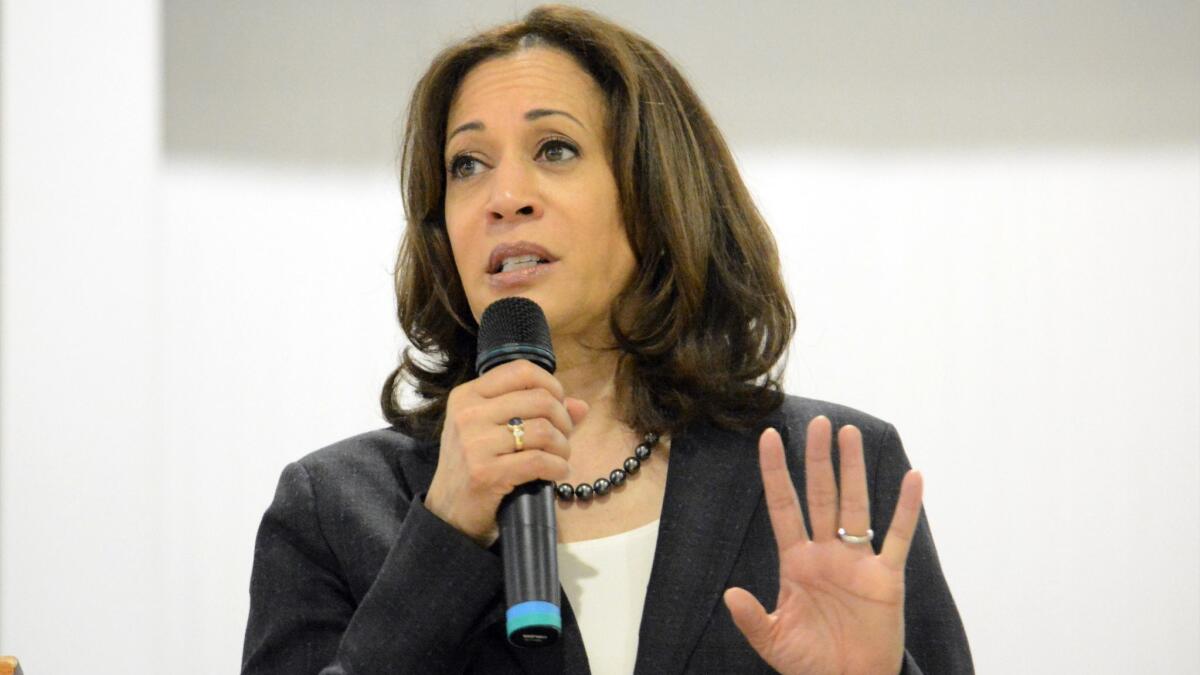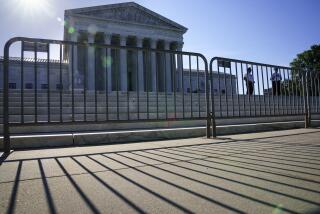Op-Ed: Expanding the Supreme Court is the worst idea yet from Democratic presidential candidates

- Share via
“Medicare for all” and the Green New Deal may be bad ideas. But they aren’t the worst ones being floated by the growing band of Democratic presidential hopefuls. That honor is reserved for the disastrous notion of expanding the Supreme Court.
So far former Rep. Beto O’Rourke, Mayor Pete Buttigieg and Sens. Kamala Harris, Kirsten Gillibrand and Elizabeth Warren have expressed a willingness to consider the idea. As Harris said: “everything is on the table” to address what she calls “a crisis of confidence in the Supreme Court.”
For many Americans, however, the court isn’t broken. Polls consistently place public confidence in the Supreme Court higher than in Congress and the president. Those who say they want to expand the court cite high-minded reasons: individual justices have exaggerated power because of their small number; more voices on the court would produce more thoughtful decisions; a larger court would have more gender and racial diversity.
The biggest reason Democrats love the idea is simple political retaliation.
But the biggest reason Democrats love the idea is simple political retaliation. They believe that Republican senators stole a Supreme Court seat in 2016 by refusing to vote on Merrick Garland, President Obama’s nominee to replace Justice Antonin Scalia. They argue that keeping the seat open for Neil M. Gorsuch in 2017 unfairly tipped the Supreme Court toward conservatives.
Keeping the Scalia seat open, however, just escalated an ongoing fight over judicial appointments. Senate Democrats launched the spiral with their unprecedented attacks on Robert Bork and Clarence Thomas in the 1980s and 1990s. They descended furthered in the mid-2000s by filibustering for the first time to block prominent George W. Bush nominees to the federal appeals courts. Then, as the 2014 election approached, Democrats eliminated the filibuster to rush through Obama’s last judicial picks.
While the new Senate Majority Leader Mitch McConnell kept the Scalia seat open so that the next president could appoint his or her own nominee (a move previously threatened by Democrats during Bush’s last year), Democrats retaliated by filibustering Gorsuch. In response, Republicans eliminated the filibuster for Supreme Court nominees.
Expanding the Supreme Court would go far beyond this kind of tit-for-tat. Until now, Democrats and Republicans have fought over internal Senate procedures. Senators have the right to choose the rules that govern their own deliberations. But changing the court’s size to alter its outcomes and jurisprudence would constitute Senate interference with the judiciary.
Today’s proposal by progressives are even more threatening to republican government than Franklin D. Roosevelt’s failed 1937 attempt to pack the court. FDR sought to expand the court because of its opposition to the New Deal. He claimed the justices still lived in a “horse and buggy” era and could not grasp the need to regulate a nationwide economy. Thus, he would appoint six new justices to “help” the older justices. While Congress rejected FDR’s cynical plan, the threat pressured the justices into upholding the New Deal.
Roosevelt’s failed proposal at least had the virtue of removing judicial obstacles to policies supported by the two-thirds of the American people who supported his reelection and voted for Democratic majorities in Congress. Today, Democrats want to alter the Supreme Court for the opposite reason: to change laws and create new rights they know wouldn’t make it through Congress or a popular vote.
Enter the Fray: First takes on the news of the minute »
If Democrats win in 2020 and launch this attack on judicial independence, a rapid descent of the court into pure politics will surely follow. They might be able to get support for expanding the court to whatever number they would need for a progressive majority. (Eleven? Fifteen?) But then Republicans will merely return the favor when they regain power. And Democrats and Republicans will continue to nominate justices who pass their litmus tests and will pursue their agendas, especially as the court’s size starts to resemble a legislature rather than a court. It would be a classic race to the bottom, at the price of judicial independence and the rule of law.
The Constitution leaves the size of the Supreme Court up to Congress, and the number of justices fluctuated during the country’s first eight decades. In 1789, the first Supreme Court had six seats, and then varied between five and 10. But in 1869, Congress set the number at nine, and it hasn’t changed in 150 years.
The answer to fighting over the court’s direction is not to ramp up politicization of the Supreme Court, but to depoliticalize it. How? By not treating every controversial social or political issue as a constitutional one. As long as the court continues to take up and issue rulings on such things as abortion and gay marriage, the court’s size and composition will remain the subject of political conflict.
John Yoo is a law professor at UC Berkeley, a visiting scholar at the American Enterprise Institute and a visiting fellow at the Hoover Institution. James Phillips is an attorney in private practice and a nonresident fellow with the Constitutional Law Center at Stanford Law School.
More to Read
A cure for the common opinion
Get thought-provoking perspectives with our weekly newsletter.
You may occasionally receive promotional content from the Los Angeles Times.










